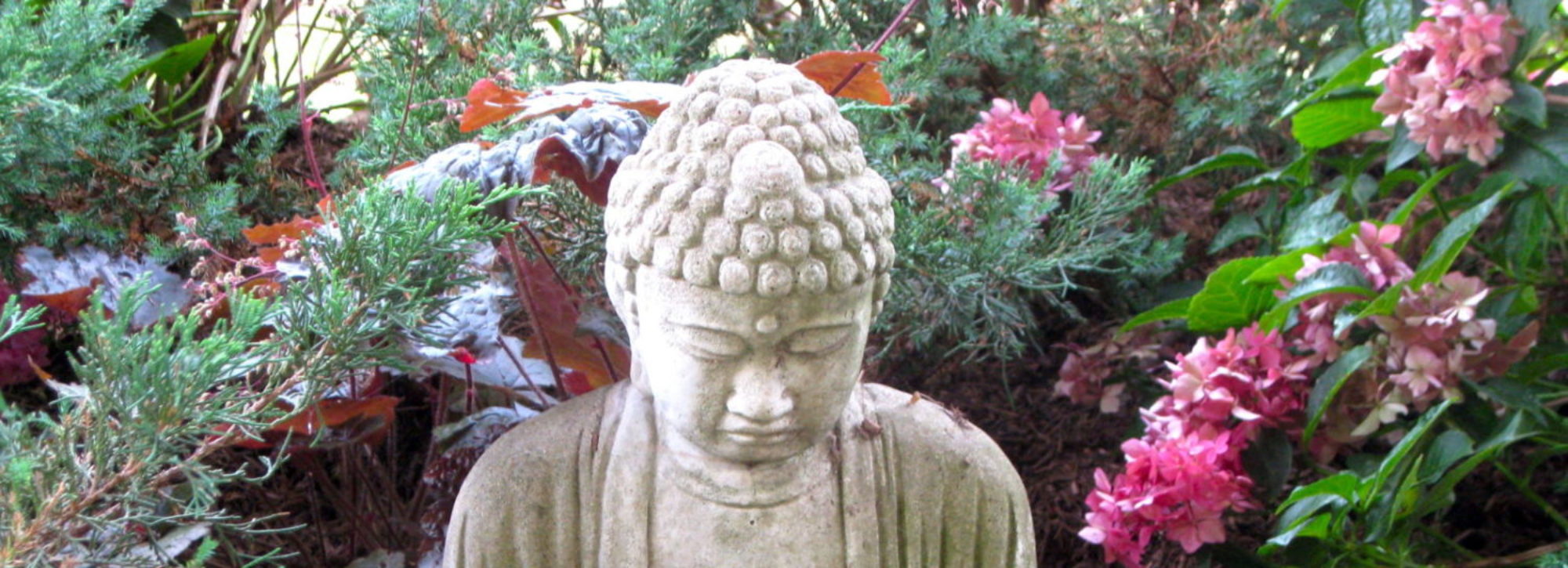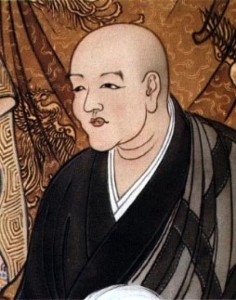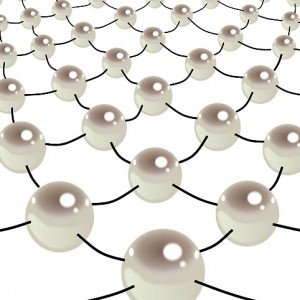I’m auditing a course on Eihei Dogen (1200-1253) that’s being taught by Taigen Dan Leighton under the auspices of the Institute of Buddhist Studies. Dogen, the founding father of Japanese Soto Zen, was a prolific writer whose essays and recorded talks are, in turns, dense, perplexing, ironic, and poetic. He had an eye for imagery, an ear for language, an encyclopedic grasp of the koan and sutra literatures, and a perverse desire to torture ideas, turning them upside down and inside out until he had wrung whatever he could from them. Reading Dogen is difficult going because it’s often hard to tell when he’s being straightforward, when he’s waxing poetic, and when he’s pulling one’s leg. He’s most challenging when he’s being absolutely straightforward because he understood “time,” “space,” and ”nature” the way a medieval Japanese person would.
Dogen’s view of time and space was influenced by the Flower Garden (Huayan) School which flourished in China from 600-845 and emphasized the ”unimpeded interpenetration” of all phenomena. The Huayan Buddhists illustrated this unimpeded interpenetration through the metaphor of Indra’s Net, and image of the universe as a vast multidimensional net with jewels lying at each of its intersecting nodes, each jewel reflecting the light of every other jewel. Each node was intimately and immediately interconnected with each and every other node, each and every node participating in and reflecting the totality. A modern physicist might reinterpret this as each and every quantum particle being intimately and immediately connected with each and every other quantum particle.
For Dogen, space is equivalent to everything that has form — objects, beings, and the distances between them. Space is inseparable from everything that’s happening within it, including our psychological states and our actions. Dogen thought that when we sit zazen, that moment is facilitated by all things in the universe, and at the same time transforms all things in the universe.
When one displays the Buddha mudra with one’s whole body and mind, sitting upright in this samadhi even for a short time, everything in the entire dharma world becomes buddha mudra, and all space in the universe completely becomes enlightenment.
—Dogen (Bendowa)
Our twenty-first century minds view space as something abstract — three Cartesian dimensions measured in invariant units, each centimeter equivalent to every other centimeter — an empty place with objects lying at specific coordinates within its grid. This is space that has been disenchanted and killed. Humans, with their feelings, intentions, morals, and sensibilities, inhabit a dead space, conscious presences in an insensate world.
Space for Dogen, on the other hand, is responsive and alive. Compassionate humans live in a compassionate Buddha-verse. Apples, after all, grow from apple trees, not from rocks. (Except that apple trees do grow from ”inanimate” minerals, at least in part!)
There is a path through which the complete perfect enlightenment of all things returns to the person in zazen, and whereby that person and the enlightenment of all things intimately and imperceptibly assist each other. Therefore this zazen person without fail… universally helps the buddha work in each place, as numerous as atoms, where buddhas teach and practice, and widely influences practitioners who are going beyond buddha… At this time, because earth, grasses and trees, fences and walls, tiles and pebbles, all things in the dharma realm in the universe in ten directions carry out buddha-work, therefore everyone receives the benefit of wind and water movement caused by this functioning, and all are imperceptibly helped by the wondrous and incomprehensible influence of buddha to actualize the enlightenment at hand.
—Dogen (Bendowa)
Our modern conception of time is also an abstraction. Time is uniform, and linear, stretching back into the past and forward towards the future. We think the only moment that actually exists is ”now,” although ”now” is inherently problematic. ”Now” is some abstract point of zero duration — an immediate past that’s already gone rushing off towards a not yet existent future, a fictional zero point that’s neither here nor there.
Dogen, on the other hand, says existence is time. Time isn’t abstract, anymore than space is. My being ”here” is also my being in ”this time.” If in Dogen’s chiliocosm all space interpenetrates, each locus intimately and immediately connected with every other locus, the same goes for time. All times interpenetrate and reflect all others, past, present and future. When we sit, we not only sit with all things, but with all times. Each blade of grass is an expression of and reflects the entire universe. Each moment is an expression and contains/reflects all moments. We talk about being ”here” and ”now,” but this is already a mistake. We’re really here/everywhere and now/every-when. We find all of space and all time reflected in just this moment, the ”moon in the dewdrop,” as Dogen says, or William Blake’s ”Infinity in the palm of your hand / And Eternity in an hour.”
”In essence, all things in the entire world are linked with one another as moments. Because all moments are the time being, they are your time being.”
– Dogen (Uji)
For Dogen, our commonplace belief that we sit now to get enlightened later is also mistaken. We’re not sitting alone — we’re sitting with all the myriad things, and not only with all the myriad things ”now,” but all the myriad things, past, present, and future. We’re sitting with all Buddhas/We are Buddhas. We are/affect ”them” and they are/affect ”us.” Awakening occurs in an unimaginable field of mutual interpenetration. In a strictly psychological sense, the Buddhas and ancestors, through their teachings and example, help us forward and beyond. Our ”future ancestors” encourage us as well — we’re pulled forward by our imagined future ”enlightened self,” and we practice for our grandchildren’s sake. But Dogen means this in more than a psychological sense. He means it in an ontological sense as well. It’s the true state of the way things are — all of reality awakened, all of reality awakening us, past, present, and future — and our awakening, not somewhere off in some distant future, but here right here, everywhere and right now, every-when. ”Just actualize all time as all being,” Dogen writes. ”There is nothing extra.”
Dogen offers us a seamless vision. Any degree of awakening I obtain (but there’s no ”I” obtaining ”it” — the ”world” and ”I,” inseparable from the very beginning, are co-awakening) is affecting/affected by everything else that’s happened/is happening/will happen, including the very nature of spacetime itself. As twenty-first century Westerners who live in a scientifically informed spacetime, Dogen’s understanding of the interaction between mind and physical reality seems alien and superstitious. Science hasn’t been able to integrate consciousness into its physicalist model except as mere epiphenomenon. Awareness is a ”ghost in the machine” that can never transform space and time.
Yet there’s something appealing about Dogen’s idea of a mental life inseparable from physical reality. As far as Dogen is concerned, there’s no reason why this seamlessness should only be a one-way street, why physical processes should only affect mental processes and not the other way around. For Dogen, this is not some supernatural spookiness (or at least nothing spookier than the quantum entanglement of particles) but, as Suzuki Roshi might say, ”the way things is.”
If modernity has killed God and disenchanted space, medieval Dogen dwelled in a spacetime filled with the awesome presence of innumerable Buddhas.
What are the consequences of our taking Dogen seriously? Of provisionally trying this vision on for size as a kind of thought experiment? The next time you sit zazen, try sitting in this space that’s intimately connected with everywhere and every-when, that’s filled with the awesome presence of innumerable Buddhas. Allow that the universe, ancestors, bodhisattvas and Buddhas, past and present, a sangha stretching throughout and pervading time and space, are present with you, co-participating in the Enlightenment of all beings and things, of space and time itself. Imagine that just as we carry the intention to care for all beings, the universe cares for us right back, that we dwell in a caring, alive, responsive space.
Is this a fairy tale, or is it a reality?
Which vision opens one’s heart? Which vision enables one to feel more intimately connected with all things? Dogen thought of life as a dream and that we live ”expressing the dream within the dream.” Seeing the world rationally and scientifically may be the best way to build spaceships to Mars, but Dogen’s vision may better actualize our full humanity here on Earth. It may also better enhance our care and concern for the each other and the planet, sustaining and reinforcing an ecological vision that allows us and our fellow species a future upon it.
As twenty-first century Westerners, we can’t undo history. The twentieth century Swiss playwright Friedrich Durrenmatt once wrote, ”What was once thought can never be unthought.” We are all children of the Western Enlightenment now. We can’t think in the exact same way that medieval Dogen did, but maybe we can recast the heart essence of Dogen’s view in a more contemporary idiom. Physicists like David Bohm and philosophers like Alfred North Whitehead have tried. Living abstractly does nothing for the human spirit. Modern concepts of space, time, and nature reinforce estrangement, isolation, meaninglessness, self-centeredness, and despair. We need a reality that’s a suitable habitat for our caring, connected presence.
Dogen’s life-world is a good place to start.
It is not only that there is water in the world, but there is a world in water. It is not merely in water. There is a world of sentient beings in clouds.There is a world of sentient beings in the air. There is a world of sentient beings within fire. There is a world of sentient beings on earth. There is a world of sentient beings in the world of phenomena. There is a world of sentient beings in a blade of grass…. Wherever there is a world of sentient beings, there is a world of buddha ancestors. Thoroughly examine the meaning of this.
—Dogen (Sansuikyo)



Will envision essence of Dogen view in zazen. Thank you for enlightening perspective.
Many blessings, Beatriz!
Seth – Thanks for another excellent essay. I particularly like the balance you strike between openness to Dogen’s ideas (and prose) and your own Western-trained, analytic intelligence.
I read somewhere that Dogen’s frequent opacity stems in part from his having often quoted earlier texts in his sentences. In the absence of quotation marks, his prose sometimes makes less (logical) sense than it would have in the original. In your experience, does that notion have a legitimate basis?
Thanks, Ben. I’ve heard Professor Griffith Foulk from Sarah Lawrence College speak about the difficulty of unrecognized quotes within Dogen’s writings. For example, his famous line in the Bendowa about only sitting and not reading the sutras or burning incense is actually Dogen quoting Tiantong Rujing, and not entirely un-ironically. Dogen is like a magpie cluttering his literary nest with images and allusions drawn from the koan literature, the mondo literature, the sutra literature, and traditional Chinese poetry. These references and allusions might have been readily understood by his 13th century audience, but can easily pass right over our heads (and leave us scratching them). This does create real difficulty for the modern reader, especially a reader not thoroughly grounded in the koan literature. The fact that Dogen wrote in the Japanese equivalent to Chaucerian English compounds these difficulties. Kaz Tanahashi spent ten years translating the Shobogenzo from medieval Japanese to modern Japanese, and another thirty translating it into English. He says (straight-forwardly? ironically?) that it reads better in English than in Japanese. Griffith Foulk is engaged in his own massive Shobogenzo translation which will include alternate readings of various passages when the meaning is ambiguous in Japanese, and will also include all the relevant original poems and koans, etc. that the passages refer to in footnotes. I imagine the pages will end up looking like pages from the Talmud. I desperately want a copy of that book when it comes out. But Tanahashi’s translation, published just last year, is written in clear, beautiful, lucid English. As far as that gets you.
“This is (Cartesian) space that has been disenchanted and killed. Humans, with their feelings, intentions, morals, and sensibilities, inhabit a dead space, conscious presences in an insensate world. ”
Seth- this is so important in the context of current psychological models of health and illness. It’s been decades since we excised ‘feelings, intentions, morals, and sensibilities’ in favour of an empirical science of humanity and that’s not been to our advantage. And the Bendowa quote that follows highlights both why and how to resolve this through the cultivation of the Noble Person.
Nice work here!
Thanks, Lynette! I love the old joke about psychology in the 20th century — “First is lost its soul, and then it lost is mind.” Well, mind is back, but just as computation.
Haha! We won’t find the Noble Person in this computational mind! Nor will it be an emergent property of any binary system. 😉
Looks like this Dogen guy was quite a jokester.
Hola, Amaury! Yes and no. His humor is always harnessed to his desire to express the Dharma in ways that will wake us up and “make us think,” or better yet, move us beyond thought. I expect he was never one to make a joke for humor’s sake. Serious fun, only.
Vast emptiness and nothing holy about does sound pretty serious, but the mountains and rivers business sounded like a mischievous call to zenny bunnies to jump out of their lairs, and the sentient beings residing in fire is provocatively hilarious. Serious fun indeed.
Highlight “We are all children of the Western Enlightenment now.” Not really, from ISIS converts in Europe to individuals who care zilch about alleged enlightenment, it is just a hollow statement. Was Hitler a child of Enlightenment….and so forth?
Reading stuff like this, and you wonder why Islam crushed Buddhism in Afghanistan and so forth….
Jay, if you read back to the beginning of that paragraph, it starts with “As 21st Century Westerners…” That’s the phrase to which “we are all children of the Western Enlightenment now” refers back to. ISIS and Hitler aren’t included in that group. But, let me now stretch that group to include ISIS and Hitler. No one is untouched by the Western Enlightenment, even if what they are doing is reacting against it. ISIS/Hitler employ technology that if the spawn of the enlightenment (the internet, suicide vests, V-2 rockets, Zyklon-B gas) in a struggle against other consequences the of the Enlightenment (Marxism, globalism, secular humanism, modern Islam). ISIS is trying to “restore” a pre-Enlightenment Islamic paradise, but they must inevitably end up thinking of that task in terms that have been touched by centuries of post-Caliphate thinking. I suspect that, despite their protestations, they too live in dead Cartesian space and time. We are all touched by modernity in an almost infinite number of ways, even if we are a retrograde force within it.